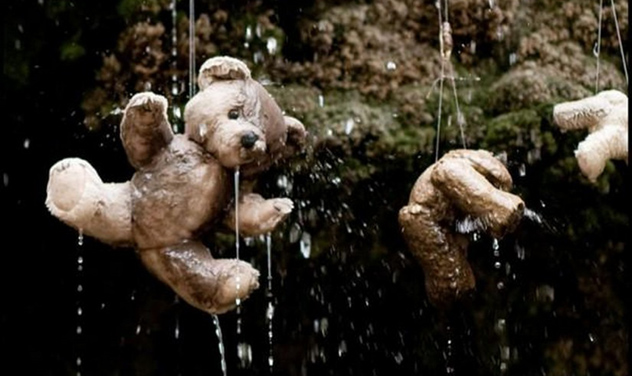 Our World
Our World  Our World
Our World  Weird Stuff
Weird Stuff 10 Fascinating Facts You Might Not Know About Snow
 Miscellaneous
Miscellaneous Top 10 Things Crypto Was Supposed to Change & What Actually Did
 History
History 10 Huge Historical Events That Happened on Christmas Eve
 Music
Music 10 Surprising Origin Stories of Your Favorite Holiday Songs
 History
History 10 Less Than Jolly Events That Occurred on December 25
 Weird Stuff
Weird Stuff 10 Funny Ways That Researchers Overthink Christmas
 Politics
Politics 10 Political Scandals That Sent Crowds Into the Streets
 Weird Stuff
Weird Stuff Ten Bizarre Facts About The Doge Meme
 Our World
Our World 10 Ways Your Christmas Tree Is More Lit Than You Think
 Our World
Our World 10 Archaeological Discoveries of 2025 That Refined History
 Weird Stuff
Weird Stuff 10 Fascinating Facts You Might Not Know About Snow
 Miscellaneous
Miscellaneous Top 10 Things Crypto Was Supposed to Change & What Actually Did
Who's Behind Listverse?

Jamie Frater
Head Editor
Jamie founded Listverse due to an insatiable desire to share fascinating, obscure, and bizarre facts. He has been a guest speaker on numerous national radio and television stations and is a five time published author.
More About Us History
History 10 Huge Historical Events That Happened on Christmas Eve
 Music
Music 10 Surprising Origin Stories of Your Favorite Holiday Songs
 History
History 10 Less Than Jolly Events That Occurred on December 25
 Weird Stuff
Weird Stuff 10 Funny Ways That Researchers Overthink Christmas
 Politics
Politics 10 Political Scandals That Sent Crowds Into the Streets
 Weird Stuff
Weird Stuff Ten Bizarre Facts About The Doge Meme
 Our World
Our World 10 Ways Your Christmas Tree Is More Lit Than You Think
10 Real Places On Earth That Seem Scientifically Impossible
The Seven Wonders of the Natural World may have been named too quickly. Wonders like The Grand Canyon and Victoria Falls are certainly big, and anyone who sees them will surely be impressed—but sheer size isn’t enough to truly leave a person in awe.
There are other places in this world, though, that are far stranger. Places that seem almost alien, as if they could only exist on a planet that evolved separately from our own. These are places that scientists have had to struggle just to understand how they ever could have been formed. Places that will truly make you wonder—not just because they’re beautiful, but because they seem to follow scientific laws that don’t exist anywhere else on earth.
10Shanay-Timpishka
The Boiling River

Deep in the amazon lies a river four miles long and unlike any other on earth. The Shanay-Timpishka is so hot that any animal that steps into it gets boiled alive. When a hapless creature wanders in, the eyes cook first, melting in its skull. Soon the animal is in too much pain to keep swimming to safety. Water fills its mouth and lungs, and it is cooked from the inside out.
The river gets as hot as 91C (196F)—and scientists aren’t completely sure why. Normally, water that gets this hot is fed by a volcano, but this one is 700km removed from the nearest one.
There is a theory, though. Scientists believe that boiling hot water from under the earth cracks through fault lines and heats up the river, making the water a geothermal system unlike any other on the earth.
9Movile Cave
The Cave With an Atmosphere of Sulfur
In south-eastern Romania, there is a cave that was locked away from the slightest ray of light for 5.5 million years—and that has a completely different atmosphere from the earth.
The cave was discovered by workers looking to set up a powerplant. They tested the ground to see if it was a safe place to build—and cracked open a pathway that leads into one of the strangest places on earth.
If you descend through the narrow shaft and past a series of tunnels, you enter a chamber with a lake of sulphuric water stinking of rotting eggs. The air there is toxic, filled with hydrogen sulphide and contaminated with 100 times the surface’s levels of carbon dioxide.
The strangest part, though, is that a whole ecosystem has survived inside it. Researchers have found 33 species inside the cave that don’t exist anywhere outside of it. They’ve adapted to survive in a sulphuric atmosphere, living by feeding off a foam on top of the stones.
8The Petrifying Well
Where Water Turns Things to Stone

In Knaresborough in North Yorkshire is a well that seems like something ripped out of a story by H. P. Lovecraft. It’s a place where water trickles down a cliff side that looks like a skeleton’s grinning face—and where anything you place under the water will turn to stone.
The process usually takes three to five months, but you can leave anything you own under the trickling water and, when you return, it will be stone. People have left everything from teddy bears to bicycles there, and every one has been transformed into a statue.
For a long time, people believed that the well was cursed by a witch. Scientists today, though, have found that the water just has an unusually high mineral content. As a result, it creates a hard mineral shell over anything it touches—just like how stalactites are formed in caves.
7Lake Karachay
The Most Radioactive Lake on Earth

Inside of what was once a Soviet Union nuclear weapon factory is a lake pumped full of more radioactive material than anything else on earth. Lake Karachay is so radioactive that you would only have to stand near it for an hour for it to kill you.
The lake was used by the Soviet Union to dump nuclear waste. They poured obscene amounts into it, and it caused major problems. In 1957, an explosion in the factory spread the radioactive particles in the lake around a 23,330km (9,000 square miles) area. Then in 1967, the waters dried up and the radioactive dust was blown a further 1,450km (900 miles) away.
Today, the water is mostly covered up with concrete to keep these disasters from happening. The area is still so toxic, though, that it makes Chernobyl look like a family-friendly tourist destination.
6Grüner See
The Park That Goes Underwater Every Spring

In Austria, there’s a park with beautiful hiking trails and benches you can jog through any autumn morning. If you visit in the spring, though, it’s a little different—in fact, you’ll need scuba gear.
The park is near the Hochschwab Mountains, which get completely covered with snow in the winter. There’s so much snow on the mountains that, when it melts, the park’s lake doubles in size—and drowns the park.
If you swim through it in the spring, you’ll see benches and bridges under the water. Even some of the alpine flowers, which normally only survive above the surface, will bloom under the water. Then, partway through the summer, the water starts to recede—and the park emerges from underneath.
5The Double Tree of Casorzo

In the countryside of Piemonte, Italy, there is an unusual sight. There is a cherry tree there that looks, in most respects, just like any other healthy cherry tree—except that it happens to growing directly on top of a mulberry tree.
This isn’t completely unprecedented. Parasitic trees have grown out of others before, but normally they are small, stunted things that live short lives before falling off. The Double Tree of Casorzo, though, consists of two fully-formed, healthy trees, each spreading its branches five meters across.
Nobody quite knows how it happened. The locals believe that a bird may have dropped a cherry seed on top of the mulberry tree. The seed grew roots that pushed through the mulberry tree’s hollow trunk and reach all the way to the soil below—letting it survive and grow into a full, healthy tree.
4The Beacon of Marcaibo
The Never-Ending Lighting Storm
![]()

In Western Venezuela over the Catatumbo River, there is a storm that never ceases. Starting at 7:00 PM every night, lightning crashes over the water for ten hours every night, 260 nights each year.
Nobody knows for sure why it happens. Up until recently, the leading theory was that it had something to do with uranium in the bedrock—although scientists are starting to doubt it. Today, the leading theory is a complicated one. It posits that the shape of the mountains causes warm trade winds to collide with cold air from the Andes. That collision is then fueled by the rapidly evaporating water below and methane from a nearby oil field.
Nobody actually knows for sure, though, why it happens. Everything about is mysterious—including one moment, in 2010, when it inexplicably stopped. One day, the storm just died down without explanation, and seemed, for a while, to be over. Then, after 6 weeks of silence, it sparked up again—and has been raging ever since.
3The Blue Pond of Hokkaido
The Kool-Aid Colored Lake


On the Japanese Island of Hokkaido there is a lake that’s unlike any other in the world. The water is a unique, electric shade of blue that shimmers and changes its shade when you look at it from different angles. As the seasons change the water changes color even more, shifting through shades of blue and green.
The lake was actually man-made. The locals set up a dam in the area and set up a reservoir where the water blocked by the dam could collect. To their surprise, though, the water it collected changed color.
Scientists believe that the water’s strange color comes from aluminum hydroxide particles that have mingled in with it. The particles reflect blue light unusually well, making its reflection of the sky above far more vivid that any body of water anywhere else on earth.
2The Ringing Rocks of Pennsylvania
At the top of a hill in Pennsylvania, there is a field full of strange rocks—and nobody knows why they’re there. There is no higher cliff side nearby, so they couldn’t have fallen through a landslide, and the natives that knew about it before European settlers arrived believed it to be a natural phenomenon.
Their being there is hardly the strangest part, though. Instead, that honor goes to the sound they make when you hit them—a chiming ring that sounds almost like the cymbal on a drum kit.
There are theories, but we aren’t completely sure why they make this strange noise. One investigating them, though, found out that they’re making it on their own. When you hit a single rock, it lets out a low frequency tone that can’t be heard by human ears. When you put them together, though, the tones interact—and that’s the sound that we actually hear.
1Kawah Ijen
The Volcano With Blue Lava


In Indonesia, there is a sulfur mine built into a volcano, and when the workers enter it at night they turn off their lights. They don’t need them—because their way is lit by the strange, glowing-blue liquid trickling down the side like lava.
Kawah Ijen is often described as a volcano with blue lava, although scientists now know the blue trickle isn’t really lava—it’s sulfur. Sulfuric gases inside heat up and burst out of it, shooting blue flames up to 5 meters into the air. The gases then condense into liquid sulfur, which spills down the mountain slopes, looking like flowing neon-blue lava.
All the sulfur in the air makes it toxic, and researchers and photographers who visit it have to wear gas masks to stay safe. The workers in the mine, though, do not—and suffer through the unbreathable air while they work in the light of a pale blue glow that’s slowly killing them—and is unlike any in the world.
+More Amazing Image Lists

If you enjoyed this list, you should probably also check out the following lists:
10 Stunning Hidden Paradises From Around The World
10 Real Places Straight Out Of A Nightmare
10 Sea Creatures That Belong On An Alien World, and
Top 10 Insects That Belong In An Alien World.








